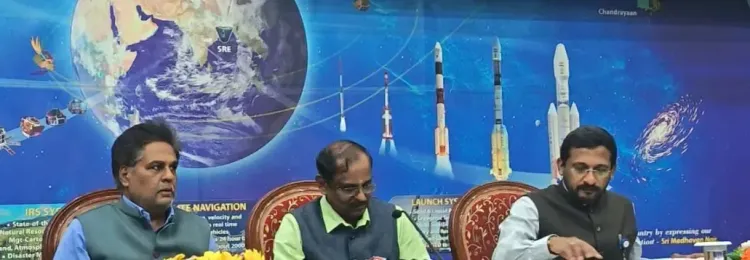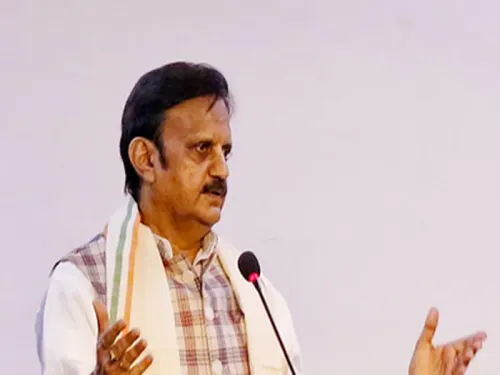Will ISRO Launch the US' BlueBird-6 Satellite Weighing 6.5 Tonnes by Year-End?

Synopsis
Key Takeaways
- ISRO is set to launch the BlueBird-6 satellite in collaboration with the US.
- The satellite weighs 6.5 tonnes and is a key communication device.
- Launch is expected by year-end, following the successful NISAR mission.
- Development of the Gaganyaan mission is nearing completion.
- ESTIC 2025 will gather leaders to advance science and technology in India.
New Delhi, Oct 23 (NationPress) The Indian Space Research Organization (ISRO) is preparing for yet another partnership with the United States, focusing on the BlueBird-6 satellite that tips the scales at 6.5 tonnes, with an anticipated launch by the end of this year, as noted by ISRO Chairman Dr. V. Narayanan during a media briefing.
This collaboration follows the success of the NASA-ISRO Synthetic Aperture Radar Mission (NISAR), which ISRO launched in July.
Dr. Narayanan stated, "The BlueBird is primarily a communication satellite. We have received the satellite and are actively preparing for the launch, with the launch vehicle assembly currently underway.”
He further mentioned that the exact date would be disclosed by the Prime Minister at the appropriate moment, emphasizing the goal of achieving this before the end of the year.
The Block 2 BlueBird communications satellite, developed by the US-based AST SpaceMobile, will be launched from the Satish Dhawan Space Centre in Sriharikota aboard India’s most robust rocket, the LVM3.
As one of the heaviest commercial satellites, the BlueBird-6 weighs in at 6.5 tonnes. This Low Earth Orbit (LEO) satellite arrived in India from the United States on October 19.
In addition, Dr. Narayanan provided updates on the Gaganyaan mission, highlighting that development for India’s inaugural human spaceflight mission is nearing completion, with around 85 to 90 percent of subsystem-level tasks finalized.
"We are currently conducting integrated tests and software validations. Three uncrewed missions will take place before any crewed flight to ensure complete safety and system reliability,” Dr. Narayanan added.
The Emerging Science, Technology and Innovation Conclave (ESTIC 2025) is scheduled from November 3 to November 5 at Bharat Mandapam, with an inauguration by Prime Minister Narendra Modi.
This event aims to accelerate advancements in key scientific fields and promote collaborations across various sectors.
Dr. Narayanan emphasized that the conclave is not solely for ISRO but encompasses the entire science and technology landscape of the country.
"Thirteen science and technology departments are participating. The event will primarily showcase our capabilities, recognize talent, and elaborate on each department's vision, including how the Indian industry and startup ecosystems contribute to science and technology, along with academic involvement,” he stated.
Dr. A. Rajarajan, Director of the Vikram Sarabhai Space Centre (VSSC) in Thiruvananthapuram, underscored the necessity for a lunar module launch vehicle to facilitate an Indian landing on Chandrayaan by 2040.
"We have configured a Lunar Module Launch Vehicle (LMLV), which is currently in the initial design and configuration stages. It needs a payload capacity of 75,000 kg in LEO,” Rajarajan mentioned.
He further emphasized advancing manufacturing capabilities for this vehicle, while highlighting the importance of industry collaboration.
"Developing any vehicle poses challenges and has its own timeline. We need to establish a comprehensive ecosystem for manufacturing while incorporating global advancements to ensure readiness for 2040,” Rajarajan explained.
ESTIC 2025 aims to convene Nobel Laureates, industry leaders, young innovators, women entrepreneurs, and emerging science leaders to define the future frontiers of science and technological innovation.









